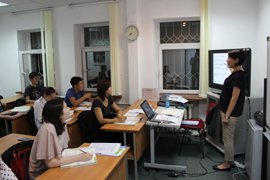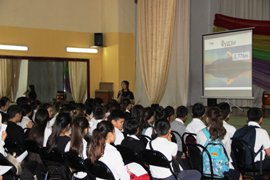Rapid Growth in Japanese-Language Education
Kyrgyz Republic-Japan Center for Human Development
SAKAMOTO Miharu
Kyrgyzstan has often been covered in the Japanese media in recent years, being described as “Pro-Japanese” or a country where the people “look just like the Japanese,” but the focus still tends to be on the nomadic tribespeople here, so it cannot be said that Kyrgyzstan is a deeply familiar country to the Japanese. However, the ratio of people studying Japanese compared to the total population is actually high, and the high level of the Japanese-language education here is well known throughout Central Asia. Furthermore, it just happens that Japanese-language education is growing very rapidly in Kyrgyzstan at this time.
According to a report by the Japanese Language Teachers Association of the Kyrgyz Republic, a group that supports Japanese-language education in the country, the number of learners has rapidly increased 1.5-fold in just the past year, and the number of applications submitted for the Japanese-Language Proficiency Test (JLPT) in the summer of 2018 was the highest yet and a significant rise again, so much so that they ran out of application forms.
The Japanese-Language Specialists (hereinafter “Specialists”) in Kyrgyzstan are dispatched to the Kyrgyz Republic-Japan Center for Human Development (hereinafter the “Center”). There I manage the Japanese-language courses geared towards the general public under the JF Standard for Japanese-Language Education while also providing support for overall Japanese-language education in Kyrgyzstan, which is growing rapidly, cooperating with the Japanese Language Teachers Association of the Kyrgyz Republic.
Expanding Japanese-Language Education for Children
Higher educational institutions located around the capital of Bishkek comprise the core of Japanese-language education in Kyrgyzstan, and highly experienced teachers provide high quality Japanese-language education in departments where students can major in the Japanese language. While the Center’s own Japanese-language courses are also highly praised and rival those of the local higher educational institutions, the age group in Kyrgyzstan with the greatest interest in Japanese-language education in recent years is actually teens in lower and upper secondary school. At the Japanese speech contest held in Kyrgyzstan in March this year, the number of applications for the elementary division, mainly comprised of teens, far exceeded the number of slots available. Those that did manage to obtain a slot gave speeches that were just as passionate as the competitors in the intermediate and advanced divisions.
One factor behind this spread in popularity of Japanese among younger generations is volunteers from Japan who are active in regional areas of the country, such as the Japan Overseas Cooperation Volunteers (JOCV), but the Specialists are also expanded the scope of learners they help as well, taking time off from running Japanese-language course at the Center to visit unified primary through lower secondary schools with Kyrgyz teachers or interact with learners at regional children’s centers.
Meeting the Needs of Diverse Learners
As the number of young learners rises, the number of Japanese companies interested in Kyrgyzstan is also rising. Because the center focuses primarily on business related human resource development, we often receive inquiries regarding hiring for Japanese-language learners or corporate language training programs. But because there are few institutions in Kyrgyzstan accepting learners for the general public on a steady basis, another important job of the Specialists is to design and establish Japanese-language courses that meet the needs for Japanese-language education specific to Kyrgyzstan. In addition to the “Marugoto: Japanese Language and Culture” Junior Course held this year during the summer holiday, and which may soon become a yearly offering, we plan on opening a Japanese-language course for business to meet the new demand.
The question remains, how do we link the various Japanese-language courses and classrooms that are both diversifying and growing rapidly? That is a major challenge now facing both Japanese-language education in Kyrgyzstan and myself as a Specialist. Kyrgyzstan is not a particularly large country, and though the number of learners is increasing, they do not have many options to learn Japanese. In order to meet the expectations of the Kyrgyz people who are interested in Japan and the Japanese language, it is necessary to create an environment in which the various educational institutions can cooperate to support the learners, including the club activities at regional schools, higher educational institutions in the major cities, and language schools for the general public.
Together with the local teachers, I hope to create such a network where people who are interested in Japan, whether it be an interest in business, in studying there, in meeting Japanese volunteers, or in Japan’s traditional culture or subcultures, can come together through the Japanese language.

Young people stand out at the evening Japanese-language courses for the general public.

A Japanese-language traveling course for teaching about Japan and its language at local schools.
- What We Do Top
- Arts and Cultural Exchange [Culture]
- Japanese-Language Education Overseas [Language]
- Japanese-Language Education Overseas [Language] Top
- Learn Japanese-language
- Teach Japanese-language
- Take Japanese-Language Test
- Know about Japanese-language education abroad
- The Japanese-Language Institute, Urawa
- The Japanese-Language Institute, Kansai
- Japanese-Language Programs for Foreign Specified Skilled Worker Candidates
- Japanese Language Education for Japanese Children Resident Overseas and for the Descendants of Migrants
- Archives
- Japanese Studies and Global Partnerships [Dialogue]
- JF digital collection
- Other Programs / Programs to Commemorate Exchange Year
- Awards and Prizes
- Publications
